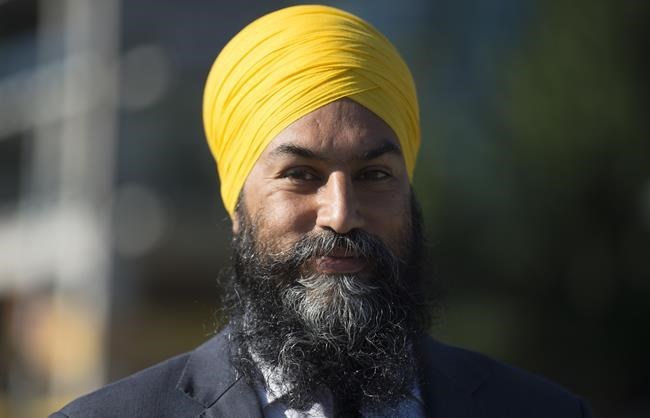OTTAWA — Under the shade of Douglas fir and western hemlock, Jagmeet Singh pulled up to Burnaby Central Park one day last week to greet constituents and gear up for his first campaign-style tour of the summer.
Ahead of a likely federal election this year, New Democrats are seeking to take back lost territory in Western Canada and once again try to convince voters there that choosing orange on the ballot does not lead to more seats tinted blue.
"Folks that are frustrated with the Liberals and that have lost faith in the Conservatives providing a real vision for Canada are going to see us as the real alternative," Singh said in a recent telephone interview from his car when he was in Burnaby.
As he looks to shift closer to the driver's seat, the NDP is casting its eye to Greater Vancouver and across the Prairies, where it often goes head to head with Tories.
"The Island, we’ve got a strong presence already" — though Green MP Paul Manly nabbed Nanaimo—Ladysmith from them in a May 2019 byelection.
"The urban centres like the Lower Mainland in B.C. is important because it represents a lot of people, and we see important opportunities for growth, for sure," Singh said.
The fourth-place party also hopes to win back city turf in Saskatchewan and shore up beachheads in spots such as Winnipeg Centre — swiped from the Liberals in 2019 — and South Okanagan—West Kootenay, which the NDP took from the Tories in 2015.
Six of the eight seats that New Democrats lost outside of Quebec in 2019 went to Conservative challengers, with the vast majority in B.C. and Saskatchewan.
Karl Bélanger, a former senior adviser to the NDP, says signs ofsagging Tory support under leader Erin O'Toole could liberate voters who might otherwise cast a Liberal ballot out of fear of splitting the vote.
"With Erin O’Toole being stuck in reverse right now, he's not seen as a credible threat by those voters who are maybe influenced by the usual Liberal campaign messaging to vote strategically to stop the Conservatives," said Bélanger, president of consulting firm Traxxion Strategies.
Ongoing turmoil in the Green party, where the party president has taken steps to oust leader Annamie Paul after an MP crossed the floor to the Liberals last month, opens the door to further potential gains in B.C., the Greens' traditional stomping grounds.
Housing affordability, environmental protection and the response to the COVID-19 pandemic remain top of mind for British Columbians, who face staggering real estate prices — increasingly outside Vancouver and its inner suburbs — and perennial wildfires.
"The NDP isn’t going to have to contort itself and change its broad message in order to align with voter concerns," said David Laycock, a political-science professor emeritus at Simon Fraser University.
"But there's all kinds of data showing people don’t necessarily vote their concerns."
Singh's high approval rating might not translate into votes either, he said, as the popular then-leader Jack Layton discovered in 2008, when his party won nine seats in B.C.
Though he's expressed concerns about a $40-billion natural gas project that Premier John Horgan backs, Singh falls largely in line with his provincial counterpart's stance against the Trans Mountain pipeline expansion and on a nuanced middle ground around old-growth forest logging.
Ongoing protests against tree cutting in Fairy Creek and other areas of Vancouver Island have rubbed some of the shine off Horgan's historic election result in October, when the B.C. NDP won a large majority mandate.
"But they don't draw a straight line between the provincial NDP and federal NDP … so I don't think that will compromise Jagmeet Singh's ability to speak to those voters," said Sanjay Jeram, senior lecturer of political science at Simon Fraser University.
In Greater Vancouver, the Liberals pose the bigger obstacle. They won three of the five ridings that cover Burnaby and Surrey in 2019, while New Democrats snagged the other two — including Burnaby South, Singh's riding. All five were two- or three-way battles where the NDP posted second or first.
"The Liberals are particularly strong, in historical terms, in Metro Vancouver right now," Laycock said, citing a recent Angus Reid poll showing them with roughly equal popularity there and in the Greater Toronto Area.
To distinguish his party, Singh points to NDP moves in the Commons that were opposed by Liberal and Tory MPs over the past nine months, including motions to abolish for-profit long-term care and impose a wealth tax and a private member's bill to usher in universal pharmacare.
A $24-million election budget and a recent poll by Leger and the Association for Canadian Studies showing 19 per cent of decided voters intend to vote NDP could energize an ambitious New Democrat campaign. That number rose to 30 per cent in British Columbia.
But the party continues to lag in Quebec — making western wins all the more essential — and faces a Liberal government keen on polishing its image as the key player in the fight against the COVID-19 pandemic and economic recovery.
Back in B.C., where 11 of the New Democrats' 24 MPs are based, Singh plans to visit ridings on Vancouver Island at week's end,including their former territory of Nanaimo—Ladysmith to rally the troops Saturday.
This report by The Canadian Press was first published July 7, 2021.
The Canadian Press



